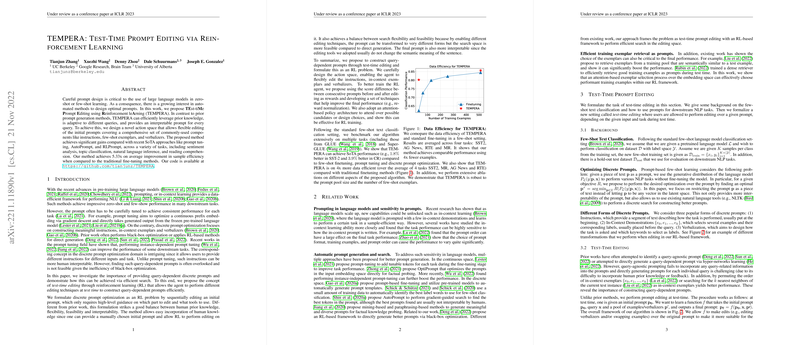Overview of TEMPERA: Test-Time Prompt Editing via Reinforcement Learning
The work presented in the paper titled "TEMPERA: Test-Time Prompt Editing via Reinforcement Learning" addresses the significant challenge of designing optimal prompts for leveraging LLMs in zero-shot or few-shot learning scenarios. Prompt design has emerged as a critical aspect in achieving high performance with LLMs across various natural language understanding (NLU) tasks. The proposed method, TEMPERA, introduces a novel approach by employing reinforcement learning (RL) to perform test-time prompt editing, effectively generating query-dependent discrete prompts.
Core Contributions
TEMPERA sets itself apart from existing methods by emphasizing query-dependent prompt editing, resulting in more adaptive and interpretable prompts relative to static or query-agnostic approaches. This is achieved through a meticulously designed action space that facilitates the editing of initial prompts, incorporating key components such as instructions, few-shot exemplars, and verbalizers. Key contributions of the paper include:
- Reinforcement Learning Framework: By framing the process of prompt editing as a Markov Decision Process (MDP), TEMPERA efficiently learns the test-time editing function. It designs a novel action space to enable effective prompt adaptation for each query.
- Sample Efficiency: The authors report substantial improvements in sample efficiency, with TEMPERA achieving on average 5.33x improvements compared to conventional fine-tuning methods in few-shot settings.
- State-of-the-Art Performance: The empirical results demonstrate that TEMPERA delivers superior performance across multiple NLP tasks, such as sentiment analysis and topic classification, when compared with state-of-the-art techniques including prompt tuning, AutoPrompt, and RLPrompt.
- Interpretable Prompts: Unlike many continuous prompt optimization methods, TEMPERA maintains the interpretability of prompts by operating in the discrete space, ensuring that the resulting prompts can be utilized and understood more intuitively by human users.
Strong Results and Claims
The paper makes several strong numerical claims, such as achieving 1.8% better performance in the SST-2 sentiment analysis task and 3.9% in the CR task over existing methods. Moreover, TEMPERA is reported to maintain robust performance over a range of tasks irrespective of the prompt pool size or the number of few-shot exemplars.
Implications and Speculations for AI Development
Practically, TEMPERA offers a significant leap in optimizing prompt design for real-world applications where adaptability is crucial, such as personalized user interactions or specific domain applications. Theoretically, it opens new avenues for integrating human-centric interpretability with algorithmic efficiency in NLP systems. The integration of RL for dynamic prompt adaptation suggests a broader future trend where AI systems can adjust on-the-fly based on contextual queries, enhancing their applicability and robustness.
Looking forward, the intersection of RL and NLP highlighted by this work could lead to more sophisticated autonomous systems capable of fine-grained customization without the need for extensive retraining. Future developments might explore broader applications to other model architectures or extend the RL-based framework to beyond-text domains where adaptability and interpretability remain key concerns. Overall, TEMPERA represents a strategic advancement in the subtle science of prompt engineering within the evolving landscape of AI technologies.
